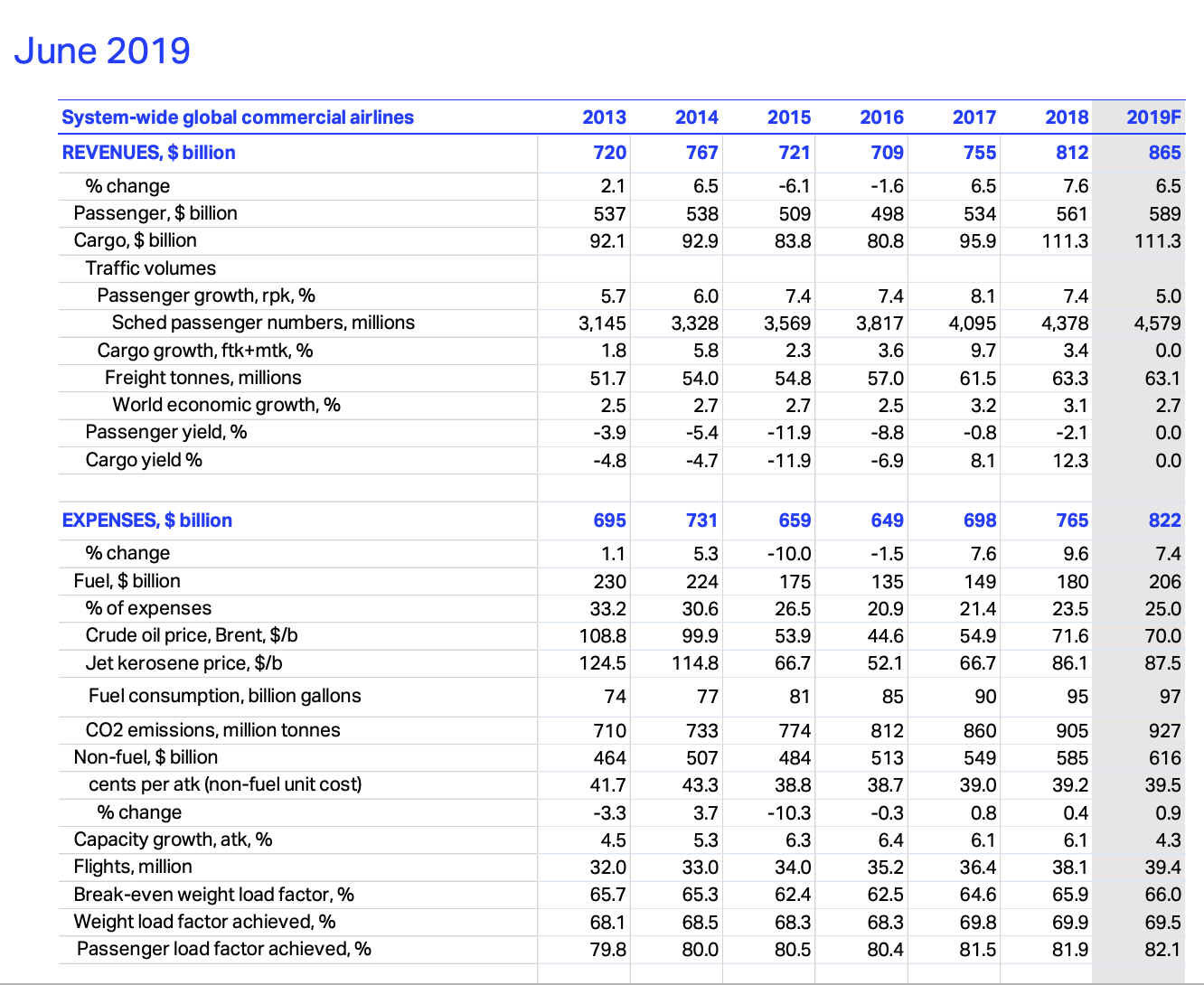IATA figures show expect global airline pax growth to 4.58 billion in 2019, with 97 billion gallons of jet fuel burned
IATA produces Fact Sheets, for a range of measures, once per month. Looking at the sheet for June 2019, it compare the figures from 2013 to forecast figures for 2019.
- The number of scheduled air passengers rose from 3,145,000,000 in 2013 to 4,579,000,000 anticipated in 2019. ie. a rise of 46%.
- The number of tonnes of air cargo rose from 51,700,000 in 2013 to 63.1 tonnes anticipated for 2019.
- The amount of jet fuel consumed was 74 billion gallons in 2013 and 97 billion gallons anticipated in 2019. ie. it rose by 31%.
- The CO2 emissions were were 710 million tonnes in 2013, and 927 million tonnes anticipated in 2019. ie. they rose by 30.6%.
- The net profit per departing passenger was $3.4 in 2013 and $6.1 anticipated in 2019.
- Global revenues for the airline industry were $720 billion in 2013, and anticipated to be $865 billion in 2019.
.
Tweet
[EPA says 1 gallon of jet fuel emits 9.75 kg of CO2. Link ]
From
IATA Industry Statistics – Fact Sheet
June 2019
Other months’ data can be found on the IATA website at https://www.iata.org/en/publications/economics
See IATA June 2019 figures at
and IATA December 2019 figures at

And
https://www.iata.org/en/iata-repository/publications/economic-reports/airline-industry-economic-performance—june-2019—report/
.
The ICCT says:
CO2 emissions from all commercial operations in 2018 totalled 918 million metric tons—2.4% of global CO2 emissions from fossil fuel use.
https://theicct.org/publications/co2-emissions-commercial-aviation-2018
.
See earlier:
IATA World Air Transport Statistics Released
6th September 2018
Montreal – The International Air Transport Association (IATA) announced industry performance statistics for 2017. Worldwide annual air passenger numbers exceeded four billion for the first time, supported by a broad-based improvement in global economic conditions and lower average airfares. At the same time, airlines connected a record number of cities worldwide, providing regular services to over 20,000 city pairs* in 2017, more than double the level of 1995. Such increases in direct services improve the industry’s efficiency by cutting costs and saving time for both travelers and shippers alike.
This information is included in the recently released 62nd Edition of the World Air Transport Statistics (WATS), the yearbook of the airline industry’s performance.
“In 2000, the average citizen flew just once every 43 months. In 2017, the figure was once every 22 months. Flying has never been more accessible. And this is liberating people to explore more of our planet for work, leisure and education. Aviation is the business of freedom,” said Alexandre de Juniac, IATA’s Director General and CEO.
Highlights of the 2017 airline industry performance:
Passenger
- System-wide, airlines carried 4.1 billion passengers on scheduled services, an increase of 7.3% over 2016, representing an additional 280 million trips by air.
- Airlines in the Asia-Pacific region once again carried the largest number of passengers. The regional rankings (based on total passengers carried on scheduled services by airlines registered in that region) are:
1. Asia-Pacific 36.3% market share (1.5 billion passengers, an increase of 10.6% compared to the region’s passengers in 2016)
2. Europe 26.3% market share (1.1 billion passengers, up 8.2% over 2016)
3. North America 23% market share (941.8 million, up 3.2% over 2016)
4. Latin America 7% market share (286.1 million, up 4.1% over 2016)
5. Middle East 5.3% market share (216.1 million, an increase of 4.6% over 2016)
6. Africa 2.2% market share (88.5 million, up 6.6% over 2016). - The top five airlines ranked by total scheduled passenger kilometers flown, were:
1. American Airlines (324 billion)
2. Delta Air Lines (316.3 billion)
3. United Airlines (311 billion)
4. Emirates Airline (289 billion)
5. Southwest Airlines (207.7 billion) - The top five international/regional passenger airport-pairs** were all within the Asia-Pacific region, again this year:
1. Hong Kong-Taipei Taoyuan (5.4 million, up 1.8% from 2016)
2. Jakarta Soekarno-Hatta-Singapore (3.3 million, up 0.8% from 2016)
3. Bangkok Suvarnabhumi-Hong Kong (3.1 million, increase of 3.5% from 2016)
4. Kuala Lumpur–Singapore (2.8 million, down. 0.3% from 2016)
5. Hong Kong-Seoul Incheon (2.7 million, down 2.2% from 2016) - The top five domestic passenger airport-pairs** were also all in the Asia-Pacific region:
1. Jeju-Seoul Gimpo (13.5 million, up 14.8% over 2016)
2. Melbourne Tullamarine-Sydney (7.8 million, up 0.4% from 2016)
3. Fukuoka-Tokyo Haneda (7.6 million, an increase of 6.1% from 2016)
4. Sapporo-Tokyo Haneda (7.4 million, up 4.6% from 2016)
5. Beijing Capital-Shanghai Hongqiao (6.4 million, up 1.9% from 2016) - One of the interesting recent additions to the WATS report is the ranking of passenger traffic by nationality, for international and domestic travel. (Nationality refers to the passenger’s citizenship as opposed to the country of residence.)
1. United States of America (632 million, representing 18.6% of all passengers)
2. People’s Republic of China (555 million or 16.3% of all passengers)
3. India (161.5 million or 4.7% of all passengers)
4. United Kingdom (147 million or 4.3% of all passengers)
5. Germany (114.4 million or 3.4% of all passengers)
Cargo
- Globally, cargo markets showed a 9.9% expansion in freight and mail tonne kilometers (FTKs). This outstripped a capacity increase of 5.3% increasing freight load factor by 2.1%.
- The top five airlines ranked by scheduled freight tonne kilometers flown were:
1. Federal Express (16.9 billion)
2. Emirates (12.7 billion)
3. United Parcel Service (11.9 billion)
4. Qatar Airways (11 billion)
5. Cathay Pacific Airways (10.8 billion)
https://www.iata.org/en/pressroom/pr/2018-09-06-01
.
.
.
